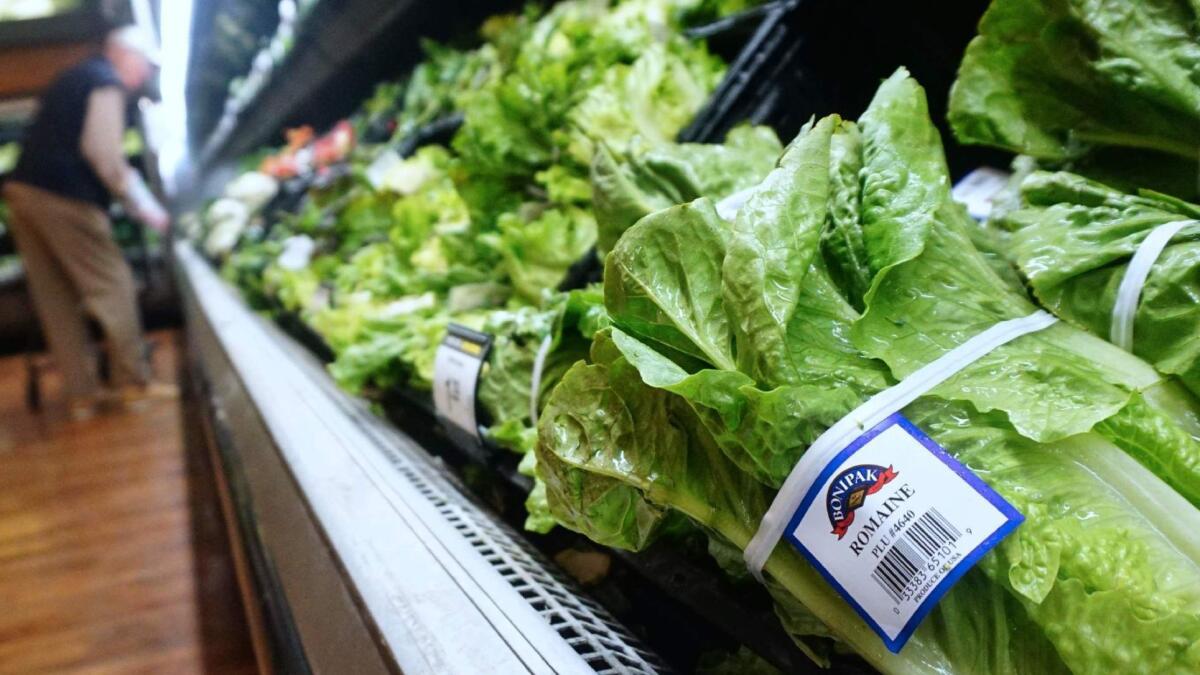Romaine lettuce made 172 people sick. Government investigators might never know why

Reporting from WASHINGTON — More than seven weeks after the start of a massive E. coli illness outbreak from romaine lettuce that sickened 172 people and caused romaine sales to plummet 45%, the Food and Drug Administration says it has no idea who or what caused the contamination.
Agency investigators have not managed to trace the affected lettuce back to one farm, processor or distributor, FDA Commissioner Scott Gottlieb said in an update Thursday. And with the affected lettuce now off shelves and the growing season over, there’s a chance the FDA may never crack the case.
The mystery has frustrated consumer advocates, who have called on the FDA to issue rules that would speed up future foodborne illness investigations. This outbreak, which began April 10, is the largest U.S. flare-up of E. coli in a decade.
On Thursday, the FDA indicated it will consider a range of reforms to improve its ability to trace the source of future outbreaks.
“We want American consumers to be confident in the quality and safety of the lettuce they consume,” Gottlieb said in a statement. “In addition to working to identify the source and mode of contamination, we will also continue working after the outbreak to evaluate what happened and how lessons learned can be used to provide feedback to industry on best practices and areas to work on.”
The new details provide further insight into a devastating E. coli outbreak — and why finding the source of the contamination has proved so difficult. Most victims fell ill after eating pre-chopped salad mixes containing romaine from different farms, the FDA said. A cluster of victims at an Alaska prison also grew sick after eating whole-head lettuce.
That head of lettuce was easily traced back to a specific farm in Yuma, Ariz., because it had not been processed or mixed with product from other places. But the agency has had a more difficult time mapping the supply chains for the bagged lettuce, which moved through multiple growers, harvesters, processors and distributors before landing on consumers’ plates.
The supply chains for the contaminated bagged lettuces don’t appear to overlap, the FDA said. Consumers bought the salads at multiple grocery stores and restaurants, and though all the lettuce came from the Yuma region, investigators haven’t identified a common farm or processing plant.
Without those usual “convergence points,” investigators have struggled to nail down where the outbreak started.
“The source and mode of contamination may remain difficult to identify,” Gottlieb said.
But some consumer advocates and industry groups have said new technologies and regulations could provide solutions — if not for this outbreak, than the next one. Walmart, for instance, has advocated the use of blockchain technology to better trace produce as it moves through the food system.
In a letter to Gottlieb last week, a coalition of nine consumer groups called for a decidedly less high-tech system: The FDA, they said, should pass mandatory record-keeping requirements for “high-risk foods” including lettuce, so that the agency has an easier time parsing through those documents during its investigations.
Congress mandated those requirements as part of the 2011 Food Safety Modernization Act, but the FDA has not acted on them.
“These actions are urgently needed in light of unsolved multistate outbreaks of pathogenic E. coli in leafy greens in recent months,” the consumer groups said, referring not only to the April E. coli outbreak but to an earlier cluster of illnesses in the United States and Canada.
The FDA, for its part, says it is weighing changes that could speed up future investigations. The agency is considering new recordkeeping standards and product labels, such as QR codes, that could encode tracking information. The FDA is also implementing new hygiene and food-safety standards for fruit and vegetable farms designed to prevent contamination.
According to one analysis by the Centers for Disease Control and Prevention, leafy vegetables were responsible for 22% of foodborne illnesses from 1998 to 2008, the latest period for which detailed attribution data is available.
A more recent analysis of outbreak data from 2013 concluded that “vegetable row crops” — lettuces plus broccoli, asparagus, celery and some other vegetables — account for 42% of E. coli infections.
“We live in an era of unprecedented innovation and technology,” Gottlieb said, “and we want to bring more of that innovation and technology to bear to help solve this problem and ensure consumer confidence in healthy fruits and vegetables.”
More to Read
Inside the business of entertainment
The Wide Shot brings you news, analysis and insights on everything from streaming wars to production — and what it all means for the future.
You may occasionally receive promotional content from the Los Angeles Times.










